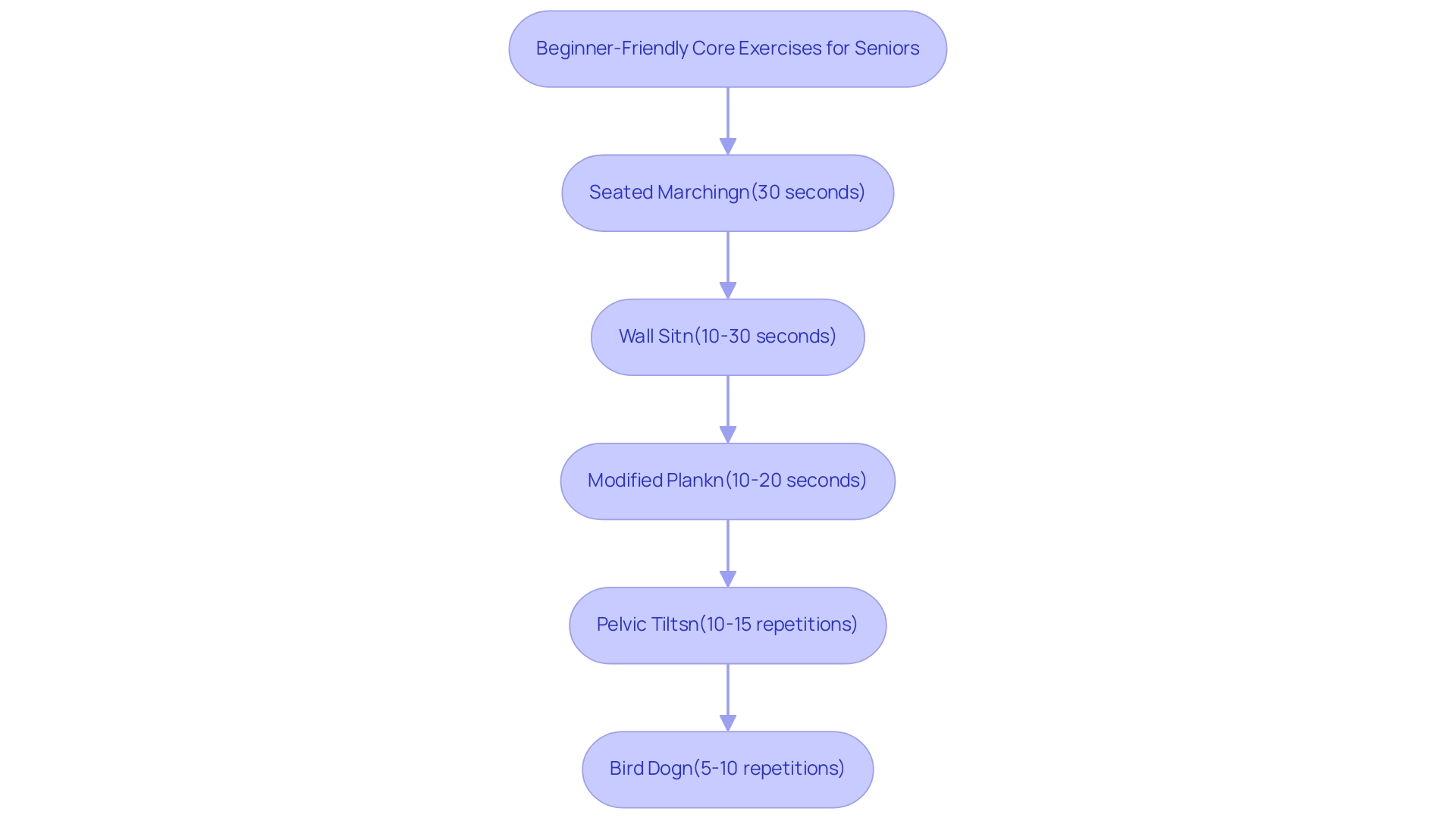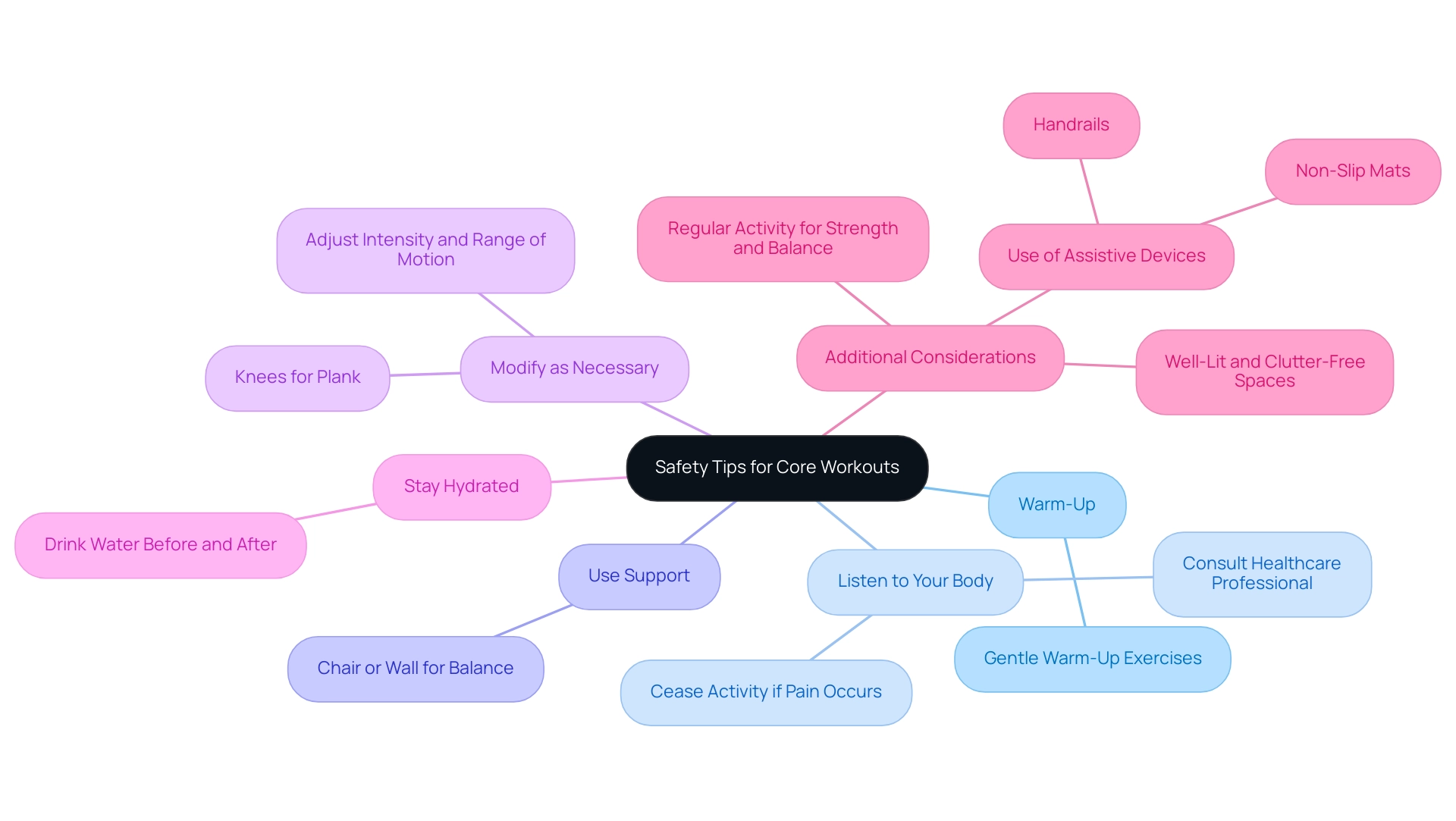Overview
The article focuses on how to safely perform core exercises specifically designed for beginners over 60, emphasizing their importance in enhancing balance, stability, and mobility to prevent falls. It outlines beginner-friendly exercises, safety tips, and the holistic benefits of core training, demonstrating that these activities can significantly improve seniors' physical health and overall quality of life while reducing the risk of injuries related to falls.
Introduction
In a world where maintaining independence and quality of life is paramount for seniors, core strength emerges as a crucial ally. As individuals age, the importance of stability and balance cannot be overstated, especially considering the alarming statistics surrounding falls among older adults.
By focusing on enhancing core strength, seniors can significantly reduce their risk of injury while improving their overall physical performance. This article delves into the transformative power of core training for those over 60, offering practical exercises, safety tips, and insights into the holistic benefits that come with a strong core.
It empowers HR Benefits Managers to take actionable steps in fostering a healthier, more resilient workforce, ultimately enhancing the well-being of older adults in their care.
The Importance of Core Strength for Seniors Over 60
Core strength is not just a fitness goal; it is crucial for seniors over 60 and can be enhanced through core exercises for beginners over 60, significantly contributing to balance, stability, and mobility. With falls being a primary cause of injury among seniors, engaging in core exercises for beginners over 60 can be a game changer in fall prevention strategies. Recent statistics indicate that while emergency department visits for individuals under 65 have decreased by 21%, fall deaths among this demographic have surged by 20%.
Moreover, the occurrence of falls in elderly individuals is alarmingly high, with studies indicating that 26.5% of seniors experience falls, emphasizing the urgency of tackling this problem. The age-adjusted fall death rate among older adults increased by 41% from 2012 to 2021, rising from 55.3 to 78.0 per 100,000 older adults, underscoring a growing public health concern that necessitates proactive measures. Engaging in core exercises for beginners over 60 not only strengthens stability but also enhances posture, reduces back pain, and boosts overall physical performance in everyday tasks.
By prioritizing essential strength, seniors can maintain their independence and significantly enhance their quality of life. As noted by Handrigan et al., there is a clear connection between body mass index (BMI) and the prevalence of falls, particularly among underweight and obese individuals, emphasizing the necessity of personalized fitness programs. In promoting fundamental strength, HR Benefits Managers can play a pivotal role in fostering a healthier, more resilient workforce among older adults.

Beginner-Friendly Core Exercises for Seniors
Here are some core exercises for beginners over 60 that are beginner-friendly workouts designed specifically for seniors, promoting both engagement and stability. These exercises can be performed for a total of 30 minutes a day, 5 times per week for 8 weeks:
- Seated Marching: Sit tall in a chair and lift one knee at a time, mimicking a marching motion. This exercise not only engages the abdomen but also enhances balance, making it perfect for daily practice.
- Wall Sit: Stand against a wall and slide down until your knees are at a 90-degree angle. Hold for 10-30 seconds, concentrating on activating your abdominal muscles. This simple move enhances the center while promoting stability.
- Modified Plank: Begin on your knees and forearms, holding your body in a straight line from head to knees. Engage your center for 10-20 seconds. This variation provides a solid foundation for building strength without straining.
- Pelvic Tilts: Lie on your back with knees bent. Gently tilt your pelvis upward while engaging your abdominal muscles, then relax. Repeat this movement 10-15 times to improve abdominal strength and pelvic stability.
- Bird Dog: Get into a hands and knees stance, stretching one arm and the opposite leg while maintaining your stability. Hold for a few seconds, then switch sides. Aim for 5-10 repetitions to improve coordination and core engagement.
These activities, including core exercises for beginners over 60, not only promote physical health but also empower seniors by enhancing their balance and confidence. As Boehm aptly puts it, "Tightness will give it stability. But we want the muscles that surround it to be flexible."
This flexibility is essential in relation to these activities, as it enables seniors to partake in movements that enhance their overall well-being. Additionally, a study titled 'Core Strengthening Activities for Elderly' highlighted that specific core exercises for beginners over 60 led to increased weight distribution stability and decreased imbalance among participants. Incorporating these easy fundamental workouts can foster a supportive environment for older adults, enhancing their overall quality of life.

Safety Tips and Modifications for Core Workouts
To ensure safety while engaging in core routines, it’s vital to implement the following strategies:
- Warm-Up: Initiate each session with a gentle warm-up to prepare your muscles and joints, reducing the risk of injury significantly.
- Listen to Your Body: Pay close attention to how your body feels. If a physical activity triggers pain or discomfort, cease the activity promptly and consult a healthcare professional.
- Use Support: Don’t hesitate to use a chair or wall for balance during activities. This can provide the necessary stability, especially for beginners.
- Modify as Necessary: Tailor the intensity or range of motion to accommodate your comfort level. For instance, during a modified plank, consider performing the movement on your knees instead of your toes to alleviate strain.
- Stay Hydrated: Maintain hydration by drinking water before and after your workout, which supports overall health and optimal performance.
Jamie Oldham, a dedicated RN, emphasizes the significance of these adjustments, stating,
By implementing simple yet impactful strategies like regular activity to improve strength and balance, ensuring well-lit and clutter-free living spaces, and utilizing assistive devices such as handrails and non-slip mats, we can create a safer environment.
Moreover, studies indicate that while 14% of older adults reported injuries related to physical activity, these incidents predominantly stemmed from overuse, suggesting that with appropriate modifications and precautions, the risk can be effectively managed. Significantly, a study disclosed that 971 fitness participants did not sustain a fitness injury, emphasizing the safety of physical activity when proper precautions are taken.
Remember, the goal is to promote a safe and enjoyable exercise experience for everyone.

Holistic Benefits of Core Training for Older Adults
Core exercises for beginners over 60 offer a wealth of holistic benefits for older adults, significantly enhancing both physical health and emotional well-being. Here’s a closer look at these advantages:
- Improved Balance: Strengthening the core is crucial for enhancing stability, which in turn reduces the risk of falls—a major concern for seniors. Enhanced central strength can result in improved balance and coordination, encouraging confidence in everyday activities.
- Improved Posture: Participating in core exercises for beginners over 60 encourages correct alignment and posture, reducing unnecessary stress on the back and neck. This not only contributes to physical comfort but also enhances overall movement efficiency.
- Enhanced Mood: Regular physical activity, including fundamental workouts, is associated with the release of endorphins, often referred to as 'feel-good' hormones. This natural boost can significantly improve mood and help reduce feelings of anxiety. As noted by researchers from the University of California, Irvine, "Emotionally satisfying and generally positive social ties afford some health protection against a backdrop of mounting physical limitations." This emphasizes the significance of social involvement in fitness programs.
- Enhanced Energy Levels: Engaging in core exercises for beginners over 60 aids improved movement efficiency, enabling seniors to experience greater energy levels during the day. This newfound energy can encourage greater participation in social and physical activities.
- Social Engagement: Participating in group exercise classes that emphasize strength training not only enhances physical health but also nurtures social connections. These interactions can combat feelings of isolation, creating a supportive community and enhancing overall quality of life.
According to a recent survey, the response rate for senior individuals regarding their physical activity patterns was 20.2%, indicating a significant interest in understanding and enhancing their activity levels. Furthermore, the case study titled "Barriers and Strategies for Increasing Physical Activity in Older Adults" illustrates the challenges faced by this demographic and suggests strategies for increasing engagement, such as promoting walkable environments and health education. By focusing on essential training, HR Benefits Managers can enable senior individuals to experience the significant advantages of core exercises for beginners over 60, resulting in enhanced balance, mood, and social involvement—key aspects of a rewarding life.

Building Core Strength: Consistency and Progression for Seniors
Developing fundamental strength in seniors necessitates a committed strategy that highlights consistency and gradual progression. Promoting physical activity interventions in long-term care facilities for older adults is essential for fostering a healthier lifestyle. Here are essential strategies to inspire and encourage success:
- Set Realistic Goals: Initiate your journey by establishing achievable targets, such as participating in fundamental workouts three times a week. This foundation will foster a sense of accomplishment and motivate ongoing commitment.
- Track Progress: Maintaining a workout journal is crucial for monitoring improvements in strength and endurance. By recording each session, seniors can visualize their progress, offering both motivation and insight into their fitness journey.
- Gradual Increase: As comfort with activities grows, it's vital to gradually increase the duration or repetitions. This step ensures that the muscles continue to be challenged, fostering ongoing development in central strength.
- Incorporate Variety: To keep routines stimulating and comprehensive, mix different abdominal exercises. This variety not only targets various muscle groups but also helps maintain engagement, making fitness a more enjoyable experience.
- Celebrate Milestones: Recognizing achievements—whether it's holding a plank longer or completing an additional set—can significantly boost morale. Celebrating these milestones reinforces the importance of consistency in workouts and encourages seniors to maintain their efforts.
Statistics from the BRFSS survey indicate that regular physical activity can significantly reduce mortality rates, with a combination of vigorous and moderate activity yielding the best results. For instance, engaging in sporadic bouts of vigorous physical activity, such as fast walking or stair climbing for one to two minutes, has been associated with a lower risk of cancer, regardless of age, as shown in a study published in JAMA Oncology. By promoting core exercises for beginners over 60, you can empower seniors to lead healthier lives, paving the way for consistent fitness habits that contribute to their overall well-being.

Conclusion
Enhancing core strength is not merely a fitness initiative; it is a vital strategy for improving the quality of life for seniors over 60. The alarming statistics regarding falls among older adults highlight the urgent need for effective intervention. By focusing on core training, seniors can bolster their stability and balance, significantly reducing the risk of injury and fostering greater independence. This article has outlined beginner-friendly exercises, safety measures, and the holistic benefits of core strength, demonstrating how these practices can lead to improved physical health and emotional well-being.
Furthermore, the journey to building core strength is one of consistency and gradual progression. Establishing realistic goals and tracking progress not only motivates seniors but also empowers them to celebrate their achievements along the way. Incorporating variety in exercises keeps routines engaging, ensuring that seniors remain committed to their fitness journey.
In conclusion, by prioritizing core strength, HR Benefits Managers can play a crucial role in creating a healthier, more resilient workforce among older adults. The impact of these efforts extends beyond physical health, enhancing mood, energy levels, and social engagement. Now is the time to take action and invest in the well-being of seniors, empowering them to lead fulfilling and active lives.




